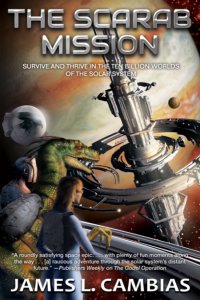Paul Di Filippo Reviews The Scarab Mission by James L. Cambias
 The Scarab Mission, James L. Cambias (Baen 978-1982192396, hardcover, 288pp, $18.00) January 2023
The Scarab Mission, James L. Cambias (Baen 978-1982192396, hardcover, 288pp, $18.00) January 2023
This rousing, unstoppable, non-stop adventure follows Cambias’s The Godel Operation (reviewed here), which introduced his cosmos of the Billion Worlds: a future where our Solar System is overstuffed with a zillion habitats, polities and species (human and other wise), some struggling for supremacy, others just following their mundane blisses. It’s a definite post-scarcity—if not even posthuman—environment, full of great venues and story potentials.
One character ports over from the first book: the manipulative masterful mech named Daslakh. But whereas in the first book, he was central to the plot engine, and even narrated events, here he is, while extremely consequential, on the periphery of the narrative, as the new characters take rightful precedence.
I cannot now recall the exact circumstances in which Daslakh found himself at the end of Godel, so I cannot say whether this book is a sequel or prequel. A truly trivial matter, for this book is perfect and perfectly self-contained, no matter what the inner chronology might be.
Having conjured up this truly unique scenario—which does admittedly have a few roots in such future histories as Varley’s Eight Worlds—Cambias took us on a panoramic magical mystery tour in the first book, across the whole system. But for this one, he’s opted to feature but a single venue: an abandoned habitat named Safdaghar, out near Jupiter. All the action—save for a few charming and necessary flashbacks—occurs in this ruined and dangerous domain. But compelling attractions and variety of scene are nevertheless not lacking. Along with the great character interactions among a vivid set of beings, there’s plenty of inventive speculative elements in a rich sensory landscape. In a sense, the tale is a blend of Big Dumb Object exploration (Rendezvous with Rama) and traversal of the death labyrinth (The Man in the Maze) motifs. Toss in the Lost/Destroyed Colony riff—the stuff of a dozen ST:TOS episodes, as well as more sophisticated iterations like Delany’s The Ballad of Beta-2—and you’ve got matter aplenty to occupy your attentions.
We start out on a sentient ship named Yanai, who is heading for the dead, out-of-homeostasis hab Safdaghar. Yanai and her crew of four organic beings are scavengers, and it is reputed that there are riches aplenty on the mysteriously extinct colony. Only at this moment, after sixteen years, is the place cosmically approachable.
Yanai’s crew consists of a dino being named Pera; a cyborg named Utsoro; a corvid-like avian named Atmin; and a human woman named Solana. This last named will serve as our mainstay POV, although we do dip into other consciousnesses.
Solana has a bad quirk in her otherwise adept and clever mental wiring, instilled deliberately by her breeders: she goes totally submissive at the bidding of any other human—triggered by facial recognition, not voice or other element—becoming their slave. Having been rescued and rehabbed, to some extent, she has a workaround for this: a pair of AR goggles that blanks out human faces, preserving her independence of will.
This quartet is soon traversing the airless, corpse-laden corridors and plazas of the hab, racking up treasure finds to make a profit. One of the biggest scores they hope to make is the last unknown verses from a poet named Pasquin Tiu, who happened to be a rebel condemned to death by the powerful government on Deimos, before his escape to Safdaghar.
The quest is dangerous enough, but complicating factors soon emerge.
There seems to be one active inhabitant left on the hab: the thing that killed all the other citizens.
And a second scavenger ship arrives. Commanded by the perversely whimsical and egomaniacally deadly woman named Jaka, these new scavengers or “scarabs” upset all the plans of Solana and Company. Soon, the crew of the Yanai are functioning more like prisoners than partners. And when Solana loses her goggles, everything goes to hell.
The midpoint introduction of a final newcomer skews the relationships even more wildly. But all the bickering has to be put aside when the original killer finally emerges wholeheartedly.
Using clever variant speech patterns—I love corvid Atmin’s Elizabethean verbal style—and a host of unforced, authentic personality “quirks,” Cambias makes all of these characters come brilliantly alive. The dialogue crackles, the motivations conflict like dueling buzzsaws, and the action flows down unpredictable yet inescapable channels.
Cambias’s portrayal of the future high-tech is like an additional character role in itself. He never relents in his crystalline depictions of stuff that approaches the Clarkean boundaries of magic. Never in the form of clunky infodumps, all the knowledge comes through elegantly.
Daring to introduce an instance of impromptu brain surgery during a life-or-death chase, Cambias entices us thus:
She made her tool into a drill and bored through his skull, going carefully, a micron at a time, and then pausing to check if she was through. Underneath the bone layer was the dura mater, a membrane thin enough to just poke her tool through, avoiding the blood vessels which showed up bright on infrared.
Inside the dura mater Solana switched to the eye in the tool tip itself, controlling it through her own implant instead of with her hands. At that scale the blood vessels in the pia mater layer hugging the brain looked like drain pipes. She was able to maneuver the tool tip around most of them but there wasn’t much she could do about the blood getting into Anton’s brain from his scalp. Either it would harm him or it wouldn’t.
The tip of the tool extended deeper into his head, pushing gently between his brain hemispheres. And there it was: his compliance implant, nestled between them like a little gray millipede snug in a pink bed. Fibers led from it to his optic and auditory nerves, and down to the brain stem.
Her plan was to locate the implant’s own tiny brain and dis-able in, leaving the comm interface intact. She switched the tool to ultrasound mode and fed the image to her goggles….
While this tale is ultimately Solana’s quest and ordeal, the supporting cast is so rich, and the action so dense, that we feel we have met about half the inhabitants of this marvelous future, the Billion Worlds.
 While you are here, please take a moment to support Locus with a one-time or recurring donation. We rely on reader donations to keep the magazine and site going, and would like to keep the site paywall free, but WE NEED YOUR FINANCIAL SUPPORT to continue quality coverage of the science fiction and fantasy field.
While you are here, please take a moment to support Locus with a one-time or recurring donation. We rely on reader donations to keep the magazine and site going, and would like to keep the site paywall free, but WE NEED YOUR FINANCIAL SUPPORT to continue quality coverage of the science fiction and fantasy field.
©Locus Magazine. Copyrighted material may not be republished without permission of LSFF






